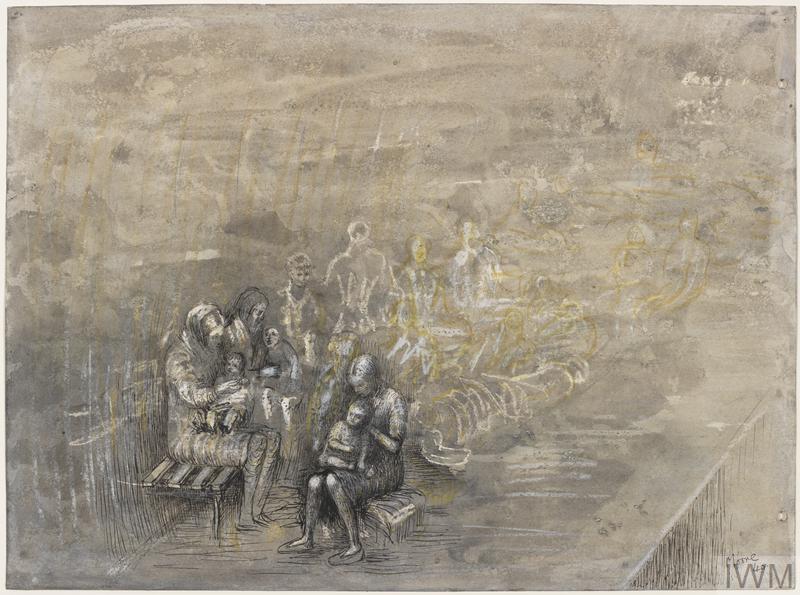Mid-Modern Blog - WWII
As stated in a previous blog post of mine, I believe that looking at the art created during war times is an incredibly important thing to do. We cannot forget the humanity present during times of struggle, cannot let artists, many of whom were fighting against oppression, risking their lives with every book, every painting, fade into memory. By viewing these pieces, we memorialize those who created them, and further thwart those who wanted them extinguished. For this blog, I would like to continue the themes I talked about in my WWI blog post with the second World War, and the art created during the horrors of this catastrophic era of human history.
Women and Children in the Tube, Henry Moore, 1940, London, England
During the time of WWII, the tube stations in England, what Americans would call the subway, had to be converted into shelters to protect civilians during air raids. Bombs would rain down upon the cities below, and while it was much safer to be inside the tube rather than out in the open, there was still often the threat of a tunnel caving in, burying those inside alive. As most of the men were out at war, the majority of those who fell victim to such attacks were women and children, as depicted in these pieces. Henry Moore spent a significant amount of his time between 1940 and 1941 traversing the tube systems on his way home, making around 300 drawings of those seeking shelter from the bombs. The use of colour in these pieces gives them a feeling of sickness and disease, with muddied yellows mixing with washed out greys while the stark-white of the figures pops out like an exposed bone. The lines are loose and rough, making me think of the shaking these tunnels must have experienced when bombs struck the earth above them. The composition is similar in both pieces; a cluster of figures in the lower-third of the piece, with a vanishing point set in the upper-third. Having more detail in the figures in the foreground catches the eye, and the more roughly drawn people in the back give a sense of the eye un-focusing due to distance.
Prisoners Carrying Cement, Bill 'Wilhelm' Spira, 1944, Poland
Of course, it wasn't just the civilians at home who were affected. The Holocaust is the first thing many of us think about when we hear the words 'World War II', and it is to this day one of if not the most horrifying point in human history. It is estimated that up to 6 million Jewish people died during this period of genocide. One Bill 'Wilhelm' Spira very nearly joined this immense number of deaths, but survived the concentration camps he was placed in, and eventually moved to Paris where he worked under both French and Swedish newspapers as a cartoonist. A large swath of his works contain things he saw at Blechhammer, a concentration camp that became a part of the Auschwitz complex. The cartoons he drew at this time all contain muted colours, likely to represent the haze of pain and sorrow that such places wrought. The lines are loosely penned, the focus being far more on the visuals and emotions of the works rather than the detail. The use of shape in his work adds to this atmosphere of pain and suffering, with guards being drawn with larger shapes, round and healthy, while the prisoners are composed of slouching, thin forms. Overall, looking at these cartoons evokes a feeling of somber quiet alongside the contextual knowledge one would have of the time period.
Evacuation From Dunkirk, May - June 1940, Puttnam and Malindine, 1940
Aside from drawn artwork, photography was a major part of WWII. Puttnam and Malindine were two photographers working in the War Office during the second World War, and heavily documented the tragedy happening around them, particularly that of the evacuation from Dunkirk. Images of soldiers on boats and laying wounded in stretchers were only a piece of the many things these men witnessed. The black-and-white colour of the images, while merely a byproduct of the camera technology at the time, give the photos a more solemn feeling. I can't help but stare at the crowds of young soldiers and wonder just how many of them lived past the dates these photos were taken. The compositions are crowded, yet save enough room to show what the photographers wanted us to focus on. There's a far different feeling of space between the two pictures; in the first, the ocean almost acts as a vast spread of negative space, emphasizing the immense bulk of the ship, whereas the second fills the center of the image with the wounded man and the soldier tending to him, making it clear where exactly we should be putting our attention. As stated before, it is important to remember the humanity involved in such brutal undertakings as war, and photographs such as these help us to remember that a real human life ended with digit in those sickeningly large death estimations.
Sources:
Henry Moore: https://www.iwm.org.uk/collections/item/object/19450 - https://www.tretyakovgallerymagazine.com/articles/1-2020-66/henry-moore-artist-wartime
Bill Spira: https://www.iwm.org.uk/collections/item/object/2307 - https://www.theguardian.com/artanddesign/2021/apr/08/jewish-austrian-cartoonists-who-fled-the-nazis-three-with-a-pen-exhibition
Puttnam and Malindine: https://www.iwm.org.uk/collections/item/object/205197162








Jeks, I like how you highlighted the importance of viewing art created during war times and how it helps memorialize those who created them, as well as reminds us of the humanity present during times of struggle. The drawings and photographs you chose give the perspective of the horrors of war.
ReplyDelete